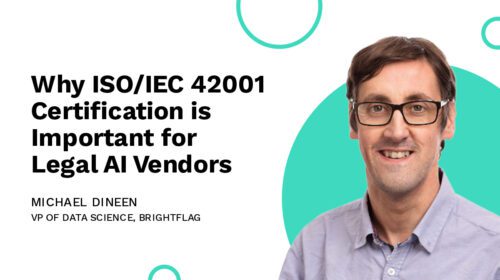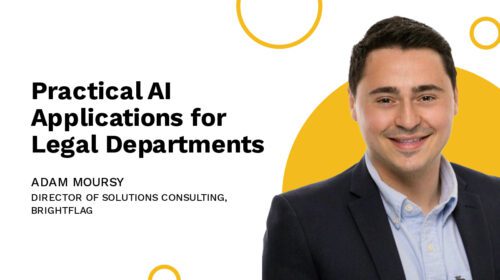Making the Case for Dedicated Legal Operations Software
Most corporate legal departments have to go through multiple rounds of planning, pitching, and persuading before gaining authorization to make their first legal operations hire.
It’s one reason why expectations are so high for whoever enters the role.
And if that person hopes to deliver the results they were hired to achieve, they’ll need to prepare for a similar process when making the case for dedicated legal operations software.
Here’s our best advice for legal ops pros wondering how to approach these pivotal conversations.
What is Legal Operations Software?
Legal operations software is a label that applies to a broad range of products. The category is expanding as quickly as the community it serves.
But if we compare the perspectives of both legal industry insiders (ex. CLOC) and software market analysts (ex. G2), we can see an emerging consensus around the most common solution types.
These include:
Legal request intake
Helps in-house legal teams capture, prioritize, and respond to their business colleagues’ requests for legal assistance.
Matter management
Helps in-house legal teams organize and track the documents, communications, tasks, and timelines that surround a legal matter.
Legal spend management
Helps in-house legal teams process, report, predict, and control outside counsel expenses.
Contract lifecycle management
Helps in-house legal teams accelerate the initiation, negotiation, execution, retrieval, and renewal of business contracts.
Document management
Helps in-house legal teams store, access, and track files securely.
Knowledge management
Helps in-house legal teams document, centralize, and share their collective expertise with colleagues.
IP management
Helps in-house legal teams centralize records related to their intellectual property assets and facilitate activities associated with defending and expanding their portfolios.
eSignature
Helps in-house legal teams digitally and securely verify identities and execute agreements.
eDiscovery
Helps in-house legal teams review, categorize, and produce electronic records that may be relevant to investigations or litigations.
Analytics
Helps in-house legal teams structure data, perform analyses, and report insights.
Each of these solutions may exist as a standalone product or as one component of a larger platform. Enterprise legal management platforms, for example, typically combine elements of document, matter, and spend management.
But they all share a common objective.
Legal operations software of every type helps corporate legal departments develop more efficient processes and pursue more efficient strategies.
When is it Time for Legal Operations Software?
The work of legal operations has existed for as long as corporate legal departments themselves. The category of legal operations, by contrast, is only a few decades old.
As a result, in-house legal teams have a long history of making do with limited tools and filling in the gaps with manual workarounds. And company executives have readily encouraged this (seemingly) cost-conscious approach.
But with more specialized solutions now available, it’s worth reevaluating whether low-tech traditions are still in the best interest of the business.
Whether manual, automated, or somewhere in between, every legal operations workflow should be periodically assessed against the same criteria. And a persistently low rating on any of these five dimensions could signal an opportunity for a high-impact legal tech investment.
Visibility
Awareness is the most basic standard of legal operations success. You can’t access resources, manage risks, pursue opportunities, or report results you’re unable to see.
An effective eDiscovery process, for example, must be compatible with all file types that contain your business communications.
Insight
Not all that’s visible is valuable, however. Facts and figures need to be structured logically and analyzed intelligently before they can inspire effective decisions.
A smart contract lifecycle management solution, for example, should make it easy to sort agreements according to their expiration date.
Efficiency
The results you achieve have to be weighed against the time and money you invest. Generating more value from fewer resources is always the imperative in legal operations.
A sustainable document management system, for example, ensures attorneys spend more time strategizing matters than searching for files.
Predictability
With so much uncertainty embedded in the strategic work of corporate law, every degree of predictability you can add to the procedural work is disproportionately valuable.
A reliable legal request intake system, for example, standardizes the types of information included with each submission to ensure attorneys always have sufficient context from the start.
Integration
Corporate legal departments exist to serve other business departments. Their people, processes, and technologies should always be optimized for closer connections with the rest of the organization.
A strong legal spend management system, for example, should align with the preferred tools and workflows of the company’s Accounts Payable team.
How Do You Make the Case for Legal Operations Software?
The first step toward building a persuasive case is confirming your audience.
Any legal operations software proposal will, at a minimum, need the support of your General Counsel. More expensive tools and more challenging economic climates will likely necessitate approval from Finance leaders and C-suite executives.
Depending on the use cases you’ve identified and the business teams they’ll impact, stakeholders from Product, Engineering, Sales, Support, or HR may also play influential roles in the final decision.
Once you know who will be in the room, it’s time to strategize how you’ll win them over to your side.
Prioritize shared goals
Legal tech proposals always land better when framed as business strategy accelerators. So you’ll need to work backward from a goal or mandate shared by stakeholders beyond your department.
The promise of more predictable legal spend management would likely appeal to Finance. The potential for shorter contract cycle times could get Sales leaders to lean forward. The prospect of sharper patent prosecution might strike a chord with your Chief Product Officer.
Whatever the specifics of your use case, make their connection to company strategy clear. This will immediately change the perception of your proposal from selfish request to collective opportunity.
Model the value
Before beginning the journey toward evaluating, purchasing, implementing, and adopting legal operations software, stakeholders naturally want to know if the destination is worth the drive.
The mutual goal(s) you identified will be instructive here, but you’re ultimately trying to answer variations of:
- What frustrations will the software resolve?
- What opportunities will the software generate?
- Who will be in a better position as a result?
And every answer should prioritize three components.
Specific details enhance both the logic and emotion behind your argument. And you’ll need both factors working in your favor if you want to inspire organizational change.
Realistic projections build credibility and reduce the risk of future disillusionment. (Modeling a range of optimistic and pessimistic scenarios is always good practice.)
Financial metrics speak a language that every department understands. Whether it takes the form of revenues created or costs reduced, stakeholders will want to see the ROI of legal operations software expressed in data.
Address the alternatives
The most popular alternative to adopting legal operations software is to adopt no new technology at all. This “status quo” solution deserves the bulk of your attention.
The best way to move forward is to look back at the frustrations and opportunities you just outlined and examine the impact of inaction.
- Are the frustrations more likely to resolve, persist, or expand?
- Will the opportunities recede, remain, or grow?
- Who will prosper or suffer as a result?
Assuming you can nudge stakeholders beyond the status quo mindset, remember that buyers (or buying committees) of all types feel more confident in their decisions when presented with multiple options. You can leverage this social phenomenon in several ways.
The most obvious way to create optionality is to evaluate multiple software vendors. Contrasting features, benefits, and price points will remind stakeholders that they’re not making a binary decision for or against a technology.
And even once you’ve identified a preferred vendor, there may still be several paths to adoption. Maybe you can limit the initial product rollout to one business region, for example, and verify value before expanding your usage.
Clarify the requirements
Adopting legal operations software is not a hands-off endeavor. While it will reduce strain on the team over the long term, a certain degree of upfront investment is always a prerequisite to success.
This investment could be as little as watching 20 minutes of product onboarding videos or as great as recruiting developers to help migrate 20 years of operational data.
Whatever the requirements, be clear and be honest. It’s always better for stakeholders to raise objections early than to proceed with misguided expectations you discover too late.
Reduce the risk
Change is scary. Even when it’s a change you know you need to make. Even when you know you’ve chosen the right partner to lead you.
So your final responsibility when making the case for legal operations software is to de-risk the decision.
- What can you do to verify product and service quality?
- What can you expect from the vendor after implementation?
- What can you learn from peers who made similar transformations?
From references, reviews, and case studies to trials, workshops, and trainings, there are many ways to give stakeholders a glimpse into the future and put their minds at ease.
Let’s Start Building
Want an experienced partner to help you craft your case? Contact Brightflag today to start the conversation around your legal operations goals and what superior software could bring to your strategy.



